

El viernes 30/10 a las 11:00 tendremos el tercer encuentro del ciclo de charlas del Departamento de Física.
La tercera charla "El lado oscuro del Universo: materia oscura y su rol desde el Big Bang hasta la actualidad" va a ser a cargo del Dr. Carlos Argüelles.
La charla se va a transmitir por Youtube. Pedimos que los y las interesadas en los certificados de asistencia, comenten su presencia en la caja de comentarios de Youtube mencionando claramente nombre y apellido, así podemos anotar la presencialidad.
Adjuntamos el link de la charla: https://youtu.be/IVJdPEls0LA
Resumen:
Las observaciones cosmológicas y astrofísicas recopiladas en las últimas dos décadas muestran que solo alrededor del 5% del contenido del Universo consiste en "materia ordinaria", como protones, neutrones, electrones y fotones. El resto del contenido de materia-energía consiste en Materia Oscura (DM) (alrededor del 25%) y Energía Oscura (alrededor del 70%). Un estudio teórico riguroso de la materia oscura requiere la interconexión entre la física de partículas y la gravedad. Mientras que los efectos observacionales de la materia oscura incluyen diferentes escenarios astrofísicos que van desde el universo temprano, la formación de estructuras a gran escala, lentes gravitacionales, curvas de rotación galácticas, etc. El objetivo de esta charla es contar el 'status' actual de conocimiento acerca de la materia y su rol en la cosmología, así como el de discutir un modelo reciente en el cual participo, que podría arrojar luz sobre la naturaleza, masa y distribución de la materia oscura en el Universo.
Avisamos también que hasta el viernes 30/10 sigue habilitada la inscripción al ciclo de charlas.
Adjuntamos el formulario para pedir certificado de asistencia al ciclo: forms.gle/fzH5jgpA6LmPvsPL9
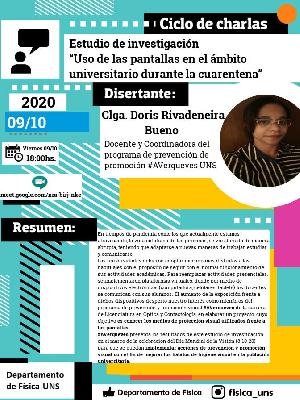
Las charlas del Departamento de Física vuelven en formato de videoconferencia.
Se van a otorgar certificados de asistencia al ciclo de charlas a las personas que asistan al 60% o más de las charlas.
Pedimos que los y las interesadas en los certificados llenen el siguiente formulario: "forms.gle/fzH5jgpA6LmPvsPL9".
La primera charla "Uso de las pantallas en el ámbito universitario durante la cuarentena" va a ser el día 09/10 a las 18 hs. a cargo de Clga. Doris Rivadeneira Bueno.
La charla se va a transmitir por Google Meet. Adjuntamos el link de la charla: meet.google.com/xra-birj-nke
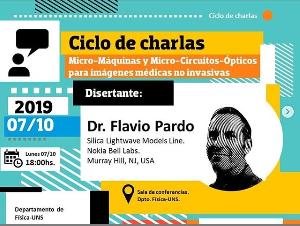
El Dpto. de Física anuncia la disertación del Dr. Flavio Pardo quien se referirá al desarrollo de un sistema de OCT (Optical Coherence Tomography) 1000 veces más chico que los sistemas actuales usando tecnologías de microfabricación en silicio y sílice, trabajo que se desarrolla dentro del área de Silica Lightwave Models en Nokia Bell Labs, Murray Hill, NJ, USA. La presentación titulada "Micro-Máquinas y Micro-Circuitos Ópticos para imágenes médicas no invasivas" tendrá lugar en la sala de conferencias de esa Unidad Académica (Ex 23H, de Av. Alem 1253)
HOY lunes 7 de Octubre de a las 18hs.
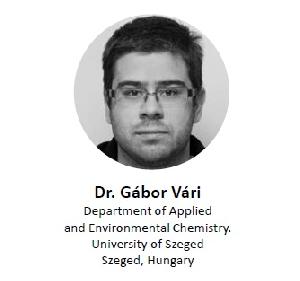
Aula 23H. Dpto. Física-UNS. Viernes 26/10. 17:30hs.
Dr. Gábor Vári
Department of Applied
and Environmental Chemistry.
University of Szeged
Szeged, Hungary
Interaction of metals with the hexagonal boron nitride monolayer studied on Rh(111)
Two dimensional monolayers (MLs) of hexagonal boron nitride (h-BN) are promising insulator components for nanoelectronics. The h-BN monolayer has a similar structure and lattice constants as those of graphene. On Rh(111) surface, monolayer h-BN forms a periodically corrugated surface structure, called “nanomesh”. This phenomenon allows its application as a nanotemplate.
Here we report on the growth of gold and rhodium on the h-BN/Rh(111) surface and on subsequent thermal effects studied by STM, XPS and LEIS. The latter technique reveals the elementary composition of the outermost atomic layer. The h-BN monolayer was formed on Rh(111) by the decomposition of borazine (BAz) at high temperatures (1000 K). Gold forms 1-2 atomic layer thick nearly 2D nanoparticles, when it is evaporated in small amounts (~0.15 ML) on the nanomesh at 300 K. At higher coverages, the growth is strongly 3D. The gold peak was observed at a rather low position (83.7 eV), indicating significant electronic interaction either with h-BN. Indeed, previous density function theory (DFT) calculations indicated an electron transfer from boron nitride to gold. The intercalation of gold is the dominant process upon stepwise thermal annealing to 1050 K, but agglomeration and evaporation also occur to a limited extent. Interestingly, though gold and rhodium form a surface alloy after intercalation, the presence of ~0.15-0.50 ML of Au below the h-BN layer does not significantly influence the nanomesh structure. At higher gold doses a partial or full flattening of the nanomesh was observed. Surface alloying of gold and rhodium and the interaction of these metals with the h-BN layer are addressed with DFT calculations as well.
We also investigated the growth of h-BN on Au-Rh alloyed surfaces varying the gold content until 4 ML. In these measurements gold was evaporated on Rh(111) at 500 K, followed by annealing at 1000 K for 5 min. Subsequently, the surface was gradually exposed to BAz at 1000 K. The exposure was increased until the whole metal surface was covered by h-BN, as shown by LEIS, but not above 260 L. Decomposition of BAz on the alloyed surface led to the attenuation of both Rh and Au LEIS (normalized) intensities and Au signal slowed down with increasing Au content. It was shown by STM measurements that up to a gold coverage of 0.5 ML, the nanomesh structure is only slightly disturbed, but larger parts are flattened at higher Au doses. LEIS studies on the growth of rhodium on h-BN/Rh(111) indicated a predominantly 3D growth, similar to the gold case. When small amounts of rhodium (up to 1 ML) were deposited on h-BN/Rh(111), intercalation was nearly complete upon annealing to ~900 K, while dewetting of the h-BN layer set in at ~1050 K. At higher rhodium doses, complete intercalation could not be reached at any temperatures.
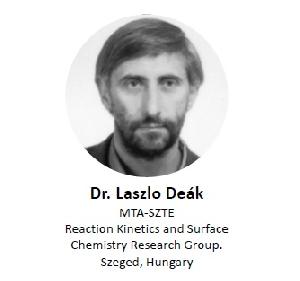
Aula 23H. Dpto. Física-UNS. Viernes 26/10. 16:30hs.
Dr. Laszlo Deák
MTA-SZTE
Reaction Kinetics and Surface
Chemistry Research Group.
Szeged, Hungary
Activation of small molecules on oxides and oxide-metal interfaces
The catalytic activation of small molecules, like CO, H2O and H2 is of importance in different processes, such as hydrogenation of CO and water gas shift reaction, for which metal oxide supported rhodium catalysts are widely applied. The critical role of metal particle-oxide interface in activating small molecules was established under high pressure conditions , but have rarely been addressed by UHV model studies. We have studied the impact of rhodium-titania and Rh-molybdena interfaces on the CO and H2O decomposition by AES, ISS, STM, XPS, TPD and sensitive temperature-programmed work function (WF) measurements.
The TiOx overlayers were formed by annealing the TiO2(110) supported rhodium, while the atomically thin MoOx deposits by the oxidation of Mo. Both oxides exerted inhibition effect on the molecular bonding of CO, which, however, was accompanied by considerable promotion of CO dissociation, maximized at 0.2-0.3 ML oxide coverages. The MoOx overlayer, having much lower surface free energy than the atomically thin TiOx film, completely covered the Rh particles by annealing to 650 K and eliminated the CO adsorption capability of the surface. On the contrary, the titania supported Rh particles showed the maximum CO dissociation propensity after annealing to 700 K. The maximization of CO decomposition is straightforwardly associated with the active role of metal particle-oxide interfaces. Desorption peak temperature for the associative CO desorption on the MoOx modified Rh particles (Tp=700 K) suggests a lower activation energy in the recombination reaction of Oa and Ca atoms, than that for the TiOx covered surfaces (Tp=800 K) which allows higher reaction rates for these intermediates in the former case. Our UHV study is in harmony with the results of high pressure experiments, concerning the formation of carbon intermediate from CO dissociation during CO methanation.
The reactions of water showed variety with the extent of reduction of titania support. Strongly reduced surfaces produced H2O and H2 desorption states with Tp=370 and 470 K, corresponding to recombinative and dissociative reaction paths of the surface OH moieties. The interaction of water with the Rh-TiOx interface was characterized with a H2 desorption state at 580 K, arising from OH groups exhibiting maximal population at intermediate TiOx coverages. The concomitant operation of inhibition and promotional effects of metal oxide overlayers on the adsorption properties of a metal could be rationalized with a simple island model. Some extreme hydrogen dissolution properties of a strongly reduced, black titania crystal have also been revealed.
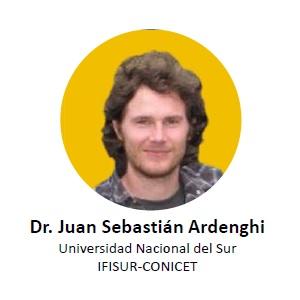
Sala de conferencias. Departamento de Ing. Eléctrica y de Computadoras.
Viernes 19/10. 16:00hs.
Dr. Juan Sebastián Ardenghi
Universidad Nacional del Sur
IFISUR-CONICET
Diagramas de Feynman en Teoría Cuántica de Campos y materia condensada
Los diagramas de Feynman revolucionaron la forma de calcular secciones eficaces en Teoría Cuántica de Campos. Mediante estos diagramas fue posible organizar y visualizar la serie perturbativa de los procesos de la electrodinámica cuántica. Mediante un conjunto de reglas sencillas, que asignan factores algebraicos a cada elemento del diagrama, fue posible reinterpretar la física involucrada y poder hacer predicciones con alto grado de exactitud. En esta charla se contará como se construyen estos diagramas, que son las antipartículas, que son las partículas virtuales y como se aplican estas técnicas a la física del estado sólido.